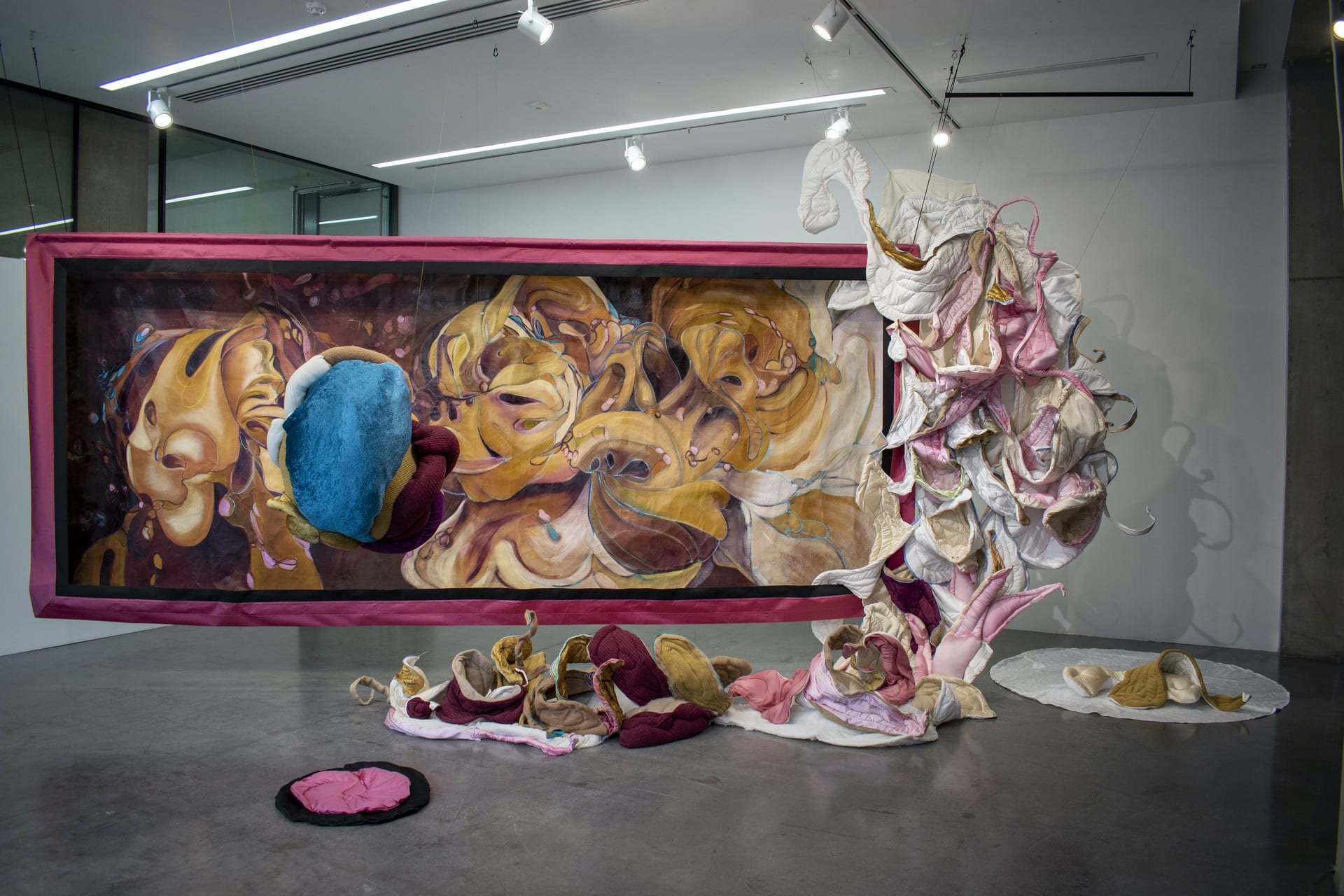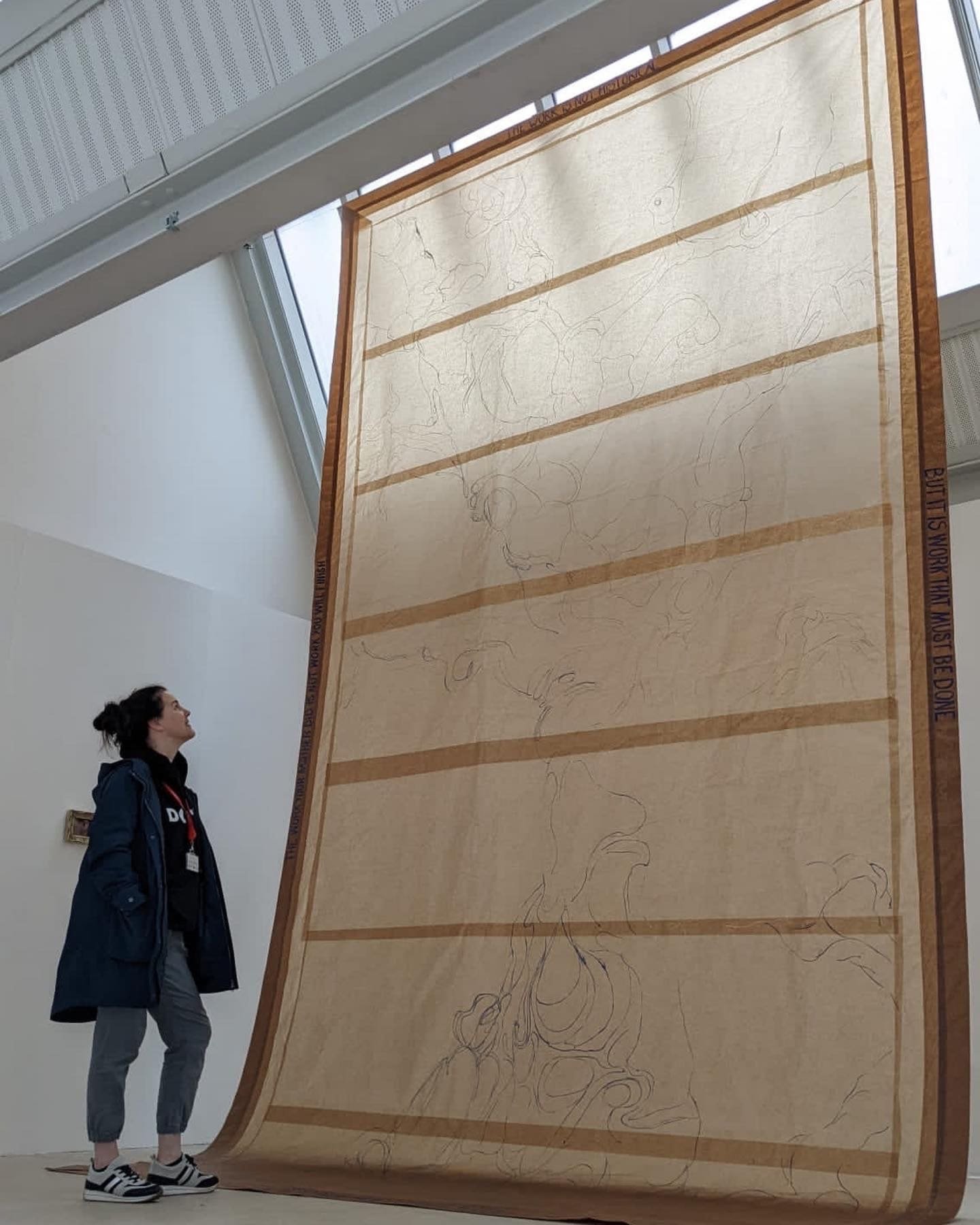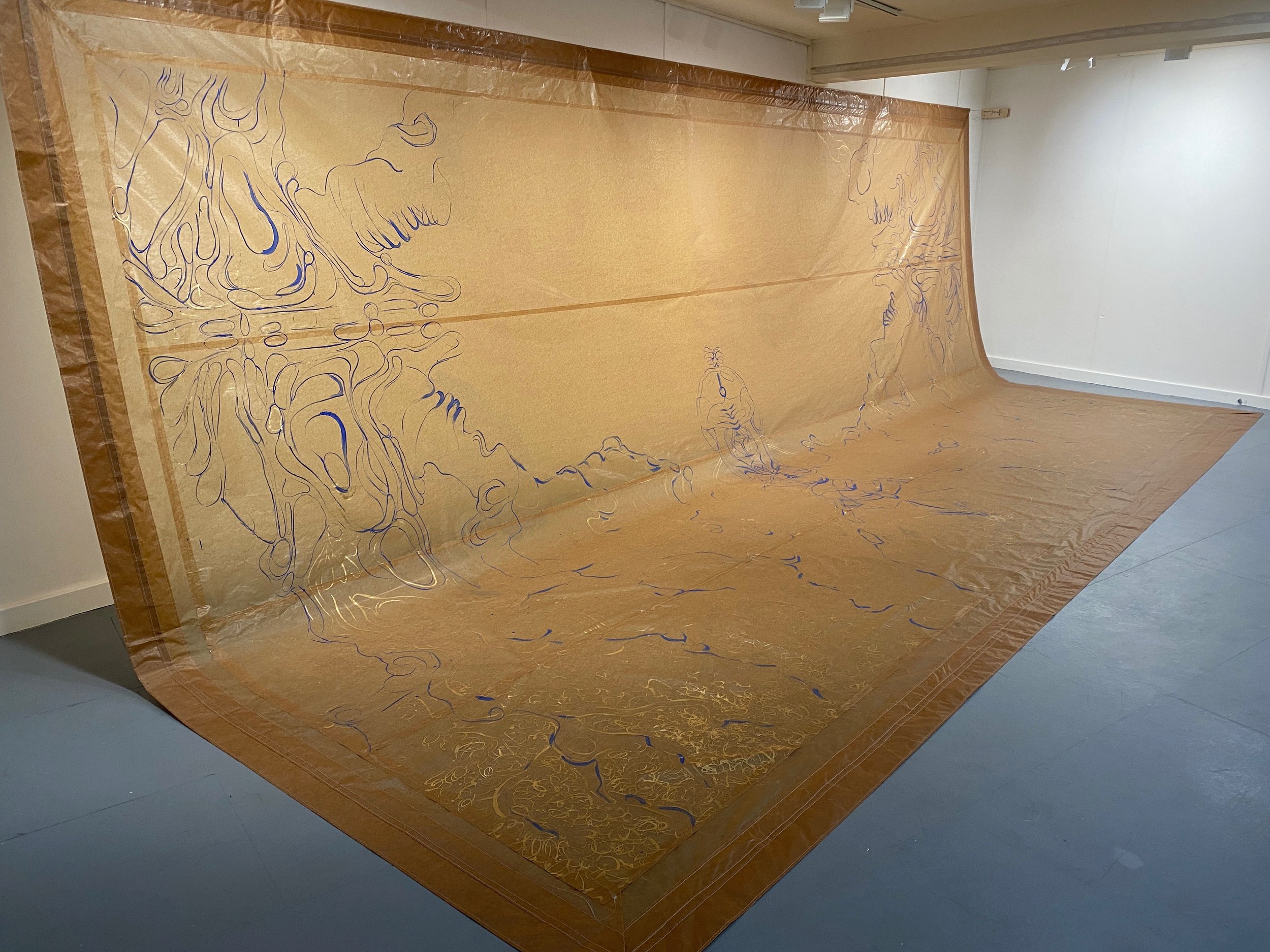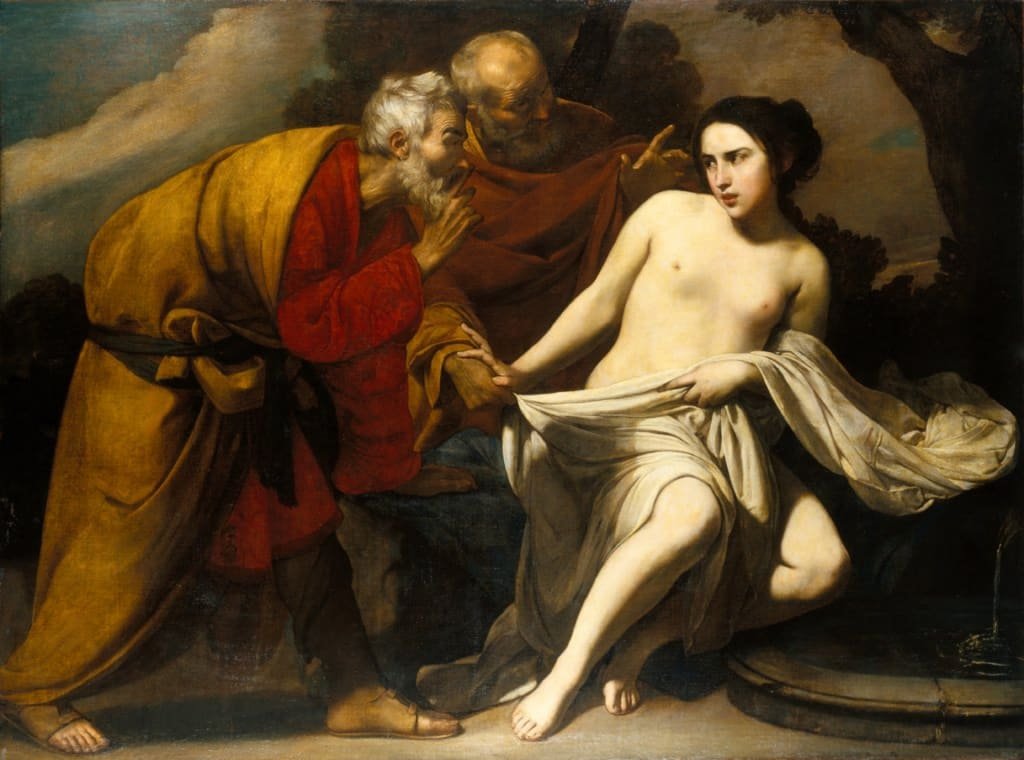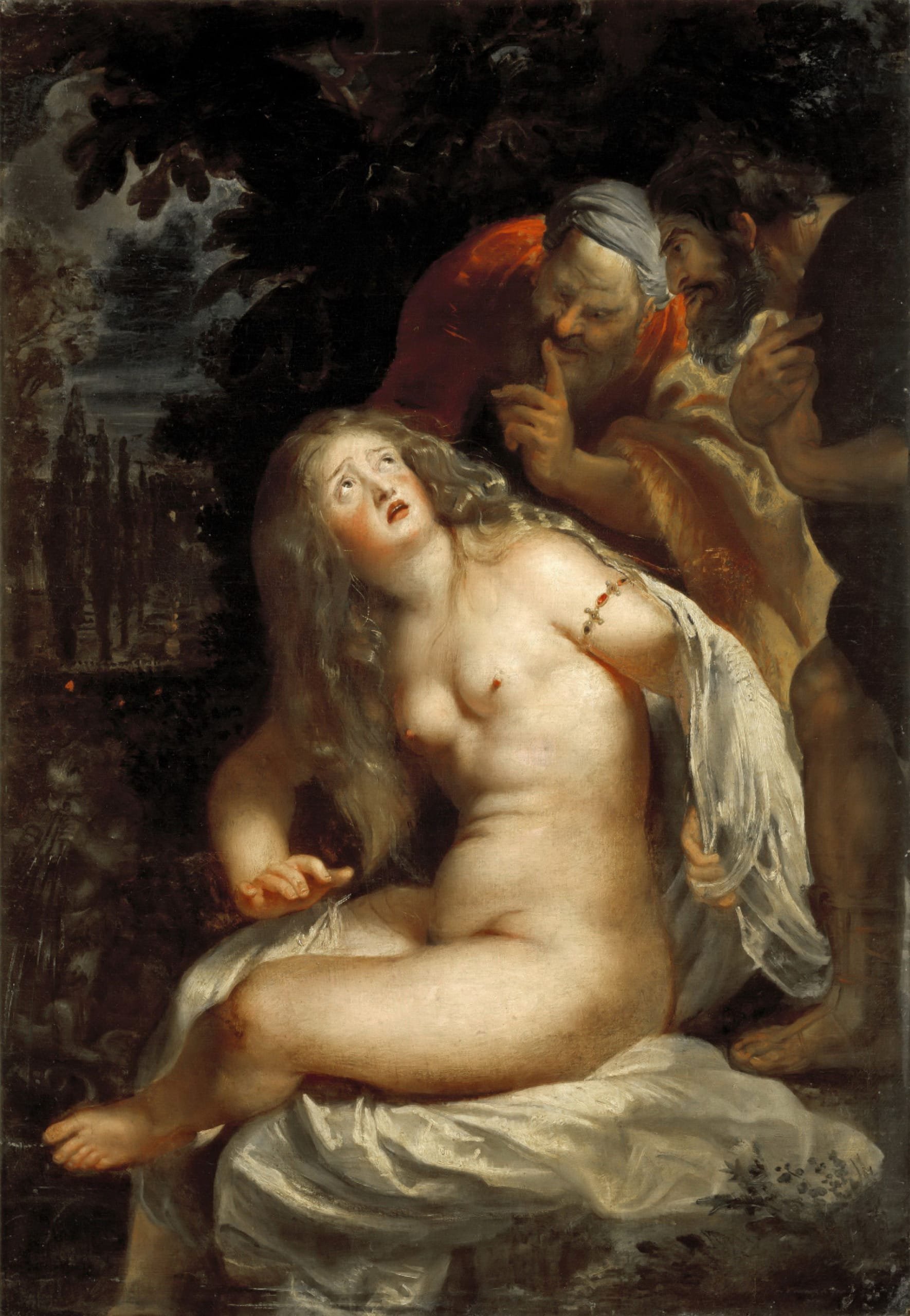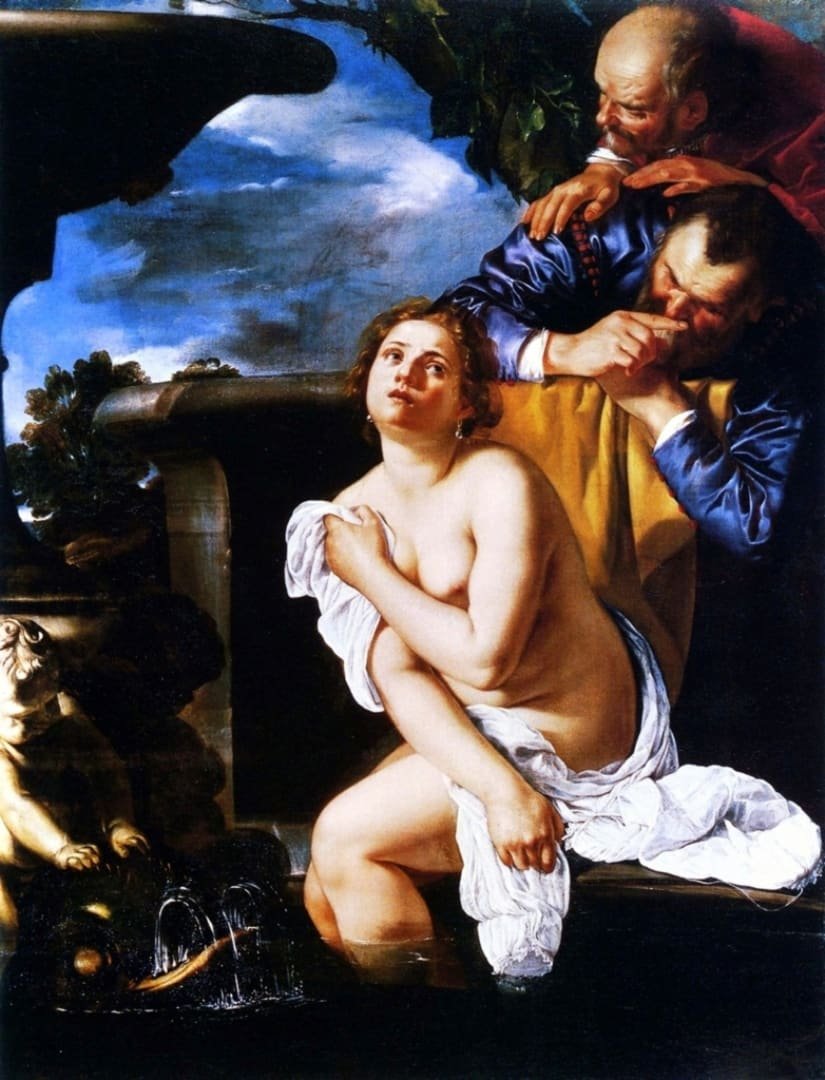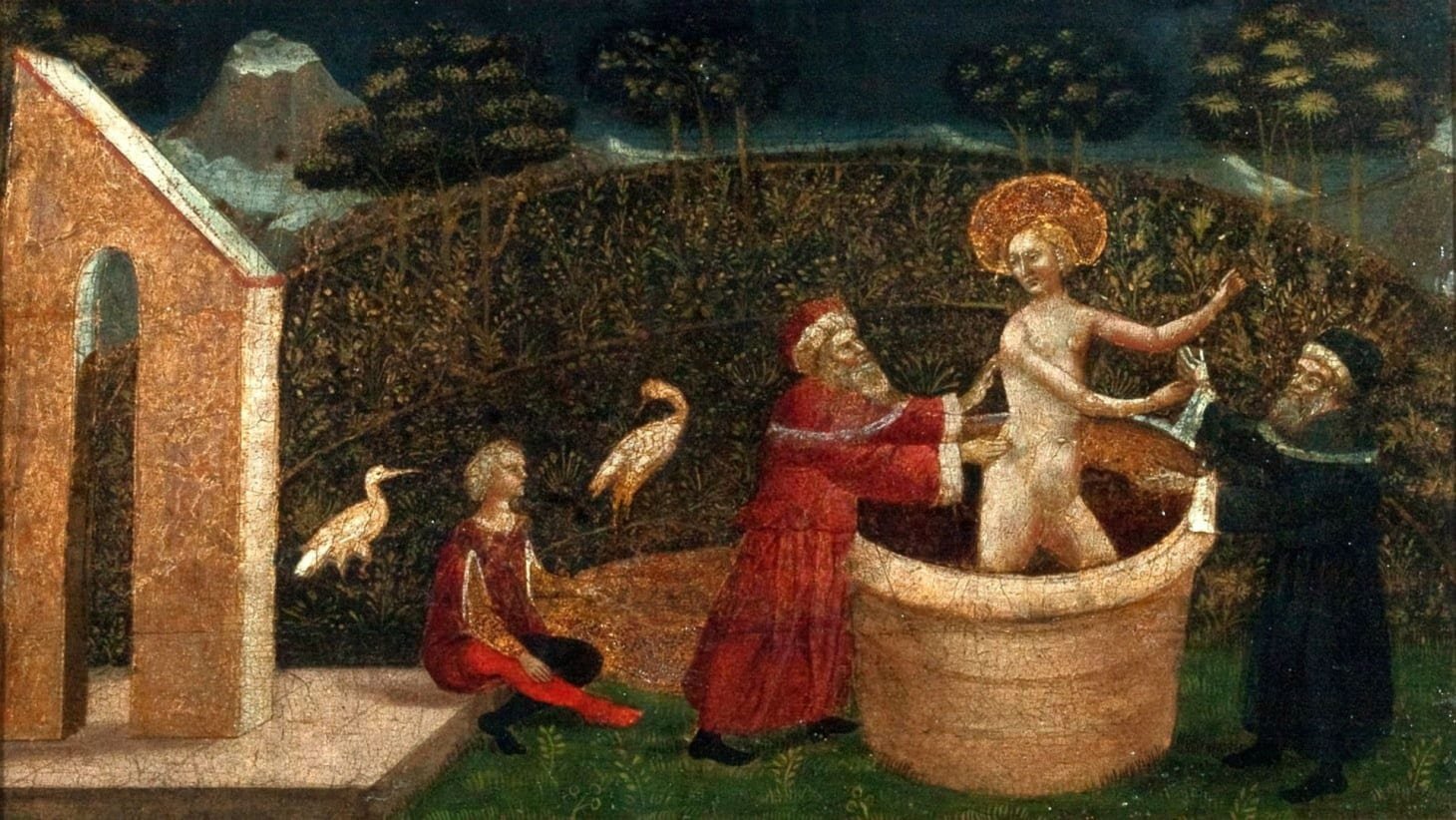SUSANNA
“In October 2020, in between lockdowns, I went with my mother to the National Gallery to see Artemisia, the first retrospective ever given to a female artist by that museum. As I stood in front of Gentileschis' Susanna and the Elders, I remembered being introduced to it as an undergrad. Painted when she was just sixteen years old, it is the first painting she signed.
The painting is larger than I expected it to be. Standing in front of it, Gentileschi's radical clarity strikes me: she is choosing her moment unlike any other painter of her day. This thought becomes the tip of the spear in my work: a willingness to let the camera roll forward and backward, to zoom in, with unflinching clarity.
In Gentileschi's 1610 Susanna and the Elders, the Elders, trusted men in her community, hang over the private wall of Susanna's garden bath. They blot out the sky as the base of an inverted pyramid of inescapable power, conspiring to gang-rape her as she, startled and afraid, begins to raise her hands and turn away.
We are so close to Susanna, we are actually submerged at her feet, only inches from the unfolding action, close enough that we could grab her by the foot, pull her in, save her. Close enough that they could get us, too. Close enough that we are her, that she is falling into us. Close enough that she can smell their breath, close enough that she knows what happens next.
A million questions crowd my mind: what happens next, if the camera keeps rolling? What happens after that, that night, the next day. What happens when she goes into work and everyone knows, or it's been posted to social media? I think about revenge porn, I think about social currency, I think about upskirting and subjugation. I pull the camera back and pause.
Subjugation: to be pressed under. To be the subject of: belonging to the beneath of - the lesser. This is about power and control. Most crimes of this type are. It's not about sex, though sex is the tool, often, with which power and control are gained.”
- Excerpts of Kate Howe’s writing on ‘Susanna and the Others’.
‘Susanna and the Others’ (After Gentileschi)
Kate Howe, 2022, installation, oil paint and oil pastel with wallboard transfer and stitching on Belgian linen, with silk frame and textile elements, painting dimensions: 220 x 488 cm, Dyson Gallery, silk frame constructed by Jowan John. Collection: Susanna, Installation, Painting, Paperwork.
Kate Howe, 2022, installation, oil paint and stitching on Kraft paper in black surround with lights and Memory totemic, variable dimensions. Collection: Susanna, Installation, Painting, Paperwork.
‘Mechanism of proof of unpickability: Encounter 1’
Kate Howe, 2022, installation, a side altar with vintage ViewMaster, archive reels and artist’s research presented in five additional reels, with damask altar cloth and devotional painting (not shown), installation view. Collection: Susanna, Installation.
“As I discovered the thousands of versions of Susanna and the Elders carved, painted, stitched, and drawn between 1011 and 1750, I began to print them out and tape them to my studio wall. After a while, my wall looked less and less like a collection of exquisite historical paintings and more and more like the wall of a serial rapist collecting photos of their crimes.
I could not escape the collective trauma in each one of these images and began to recognize the clues in the case, the clues linking these cold cases together. The same items were appearing across the centuries: the bench, the cloth, the pool, the oak tree, the mastic tree, the elders, Susanna, the hand shushing, the hand pointing to god.
The cloth. The cloak. The thing they are grabbing. Research then - research the nature of traumatic memory. If these are memories I'm seeing, like Susanna telling her story again and again: and there was a bench, and there was the cloak I was wearing, and then the sun was coming through the trees. There was a bench. If these are memories I'm catching threads of, I learn their quality so I can identify, pull through into the present, and reconstruct the timeline. Trace the tracks of the perpetrators. Follow them, doggedly, like Bosch through the centuries. Everyone counts or no one counts. I research PTSD through the US National Library of Medicine and NICBM.
In traumatic memory, sensory detail replaces narrative. The story shifts from what happened, to what was felt, seen, heard, tasted, and smelled. The experience becomes about experience as the content overwhelms our trauma centers, and we bend reality, we misdirect, and divert. We cope.
Susanna is talking to me again: and then I looked up and I remember he had his finger pressed to his lips, and his mustache curled around his finger, and his fingernail was chipped. What color was his hair? I don't know. The hair near his finger was brown and white and clumped together, I remember because it covered part of his finger. It was long. And then cold air on my arms and the feeling of the cloth falling. The sun came through the leaves really brightly. I remember seeing the sun and thinking: bright blue, aren't I supposed to think yellow when I think of the sun?
Experiencing that detail can trigger a PTSD event in which the event is re-experienced, even just fractionally or momentarily, yet completely, but which, at that moment, causes a fully-immersive and instantaneous re-experiencing of the trauma.
This is what someone means when they say they are "triggered."
Traumatic memory repeats in a loop that is always present, always happening, and always ready to become reality.
This makes me feel as though the pieces of the story that haven't been told are still there, trapped in time, hanging in air, repeating if I can tune into them. I use radio Eiko to follow the trail, to pull the threads of memory into the present, fill in the gaps, making space for the story to go differently this time.”
- Excerpts of Kate Howe’s writing.
‘Susanna, Even the Oak Betrayed You.’ (After Gentileschi with Divine Totemic)
Kate Howe, 2022, YinMn Blue oil paint and liquid gold leaf on Kraft paper with stitching, prikwork and divine totemic. painting dimensions 670 x 370 cm, Installation view. Hands: Ann Quilter, Ellen Wight, Sadie Wight, Ronan Porter, Mariam Nakiwala, Veronika Benk. Collection: Susanna, Installation, Painting.
Prickwork:
(L to R) "The moral of the story, ladies, is THIS: as long as you are a VIRTUOUS WOMAN, god will save you, no matter what kind of a pickle you find yourself in. But that's not really what the lesson is here is it? The lesson is you are not safe. These are not really images of VIRTUOUS WOMEN are they?
No. They are images of a woman being attacked by trusted Elders in her community, again and again. These elders are serial offenders, abusing through the centuries from painting to painting over and over again. It is a crime, a cold case, and there are clues to be found here. Clues that can tell us why it happens and how to make it stop”
Lettering:
Left side:
"The work your mother did is not work you will finish" Top: "The work is not historical" Right side: "But it is work that must be done"
Bottom:
"carborundorum.carborundorum 1973.1992.2022"
"Nolite te bastardes carborundorum"
Bottom Prickwork:
"A young beautiful woman and one who feared the lord. The tale of Susanna. (v.v. 2-3, NRSV)"
‘Before the Bath’ (After Gentileschi)
Kate Howe, 2022, site-specific installation, YinMn Blue oil paint and liquid gold leaf on Kraft paper with prickwork and stitching, variable dimensions, created for the show Omitted References at the Art Pavilion at Mile End, Hands: Noa Pane, Ellen Wight, Isabelle Jolliffe, Sadie Wight, Tom Wight.
Collection: Susanna, Installation, Painting.
‘Susanna, what do they owe you?’
Kate Howe, 2022, YinMn Blue oil paint and liquid gold leaf on Kraft paper with stitching, 680 x 390 cm.
Collection: Susanna, Installation, Painting.
“The story of Susanna and the Elders is an apocryphal one. It was written in about 235 BCE, but it tells a tale that purportedly happened even earlier - 600 BCE. It is a "Once upon a time" tale, a gripping cautionary tale, a tale with a moral.
The moral of the story, ladies, is this: as long as you are a virtuous woman, no matter what kind of a horrible pickle you find yourself in, God will save you. Even at the last second. Promise. But you need to be super-duper virtuous or it won't work.
The story: Once upon a time, a woman was having a bath. While she was washing, two elders of her tribe watched her, "desiring" her, neither aware of the other. These elders catch each other in the act and decide to team up and approach her together. Shared goals and all that. Or planned, premeditated gang rape, however you need to look at it.
So these elders approach Susanna and she "declines" to have sex with them. Then the story sort of fast-forwards. She tells on them, and they are arrested. There's no mention of how she got away, what it was like for her to be attacked at her home in her bath and fight these two trusted men off, or of who she told, if they believed her, or how they reacted. None of this is in the story. But we know she told on them because they are arrested.
But then the elders insist: no, no she's lying. We caught her, we spied on her, yes, but she was meeting a lover under a tree, she was fornicating, she is an adulteress!
And so Susanna is arrested. And is sentenced to death for betraying her husband. And is about to be executed in public. But God makes a miracle happen! Knowing that Susanna is INDEED super-duper virtuous, he plants an idea in the head of a young boy, spectating.
"Maybe we should question the witnesses separately!" yells prophet Daniel.
So they do, and they ask, what kind of a tree was it that she was purportedly fornicating under with her lover? One says an Oak tree. The other says a Mastic tree. The witnesses were lying. Susanna is saved. Saved at the last second ONLY because she is virtuous and God knows it.
But that's not really what we learn from this story as women, is it? We learn: we are not safe. Not even in our homes. Not even the Oak, that symbol of truth and trust surviving across centuries can protect us. We learn our bodies belong to our husbands, and if they are separate from him, they are in danger. We learn we will not be believed. We learn we must not talk. We learn to be silent.
Education is Entertaining.”
- Excerpts of Kate Howe’s writing.
Kate Howe, 2022, oil paint and liquid gold leaf on Kraft paper with stitching, 285 x 300 cm.
Collection: Susanna, Installation, Painting.
Kate Howe, 2022, site-specific installation, oil paint, liquid gold leaf, and stitching on Kraft paper.
Collection: Susanna, Installation, Painting.
EIKO
“If this is the Rupture, I'm ready for some guidance.
When I found Eiko Matsuda, I sainted her. She is our patron saint, the patron saint of women +NBX who dare to name themselves in their work: I made this. The patron saint of risk. We pray: please, let our work be our work, and let us not be mistaken for our work, though we are our work and our work is of us. Please, Let us dare to risk.
She is Eiko Matsuda. She died in obscurity in 2011 for the crime of making something new, something risky. She was erased.
I protest! I protest. I un-erase. I resurrect. I connect. I imbue. I tattoo. I make a totemic, a ritual, I place these prints with the work: a golden one with a piece that is a prayer that the story can go differently next time. A white one with pieces that come from memory, from traumatic memory, from erasure, from Eiko, from her ghost, from all of their ghosts, from the ghost over every woman in every rape in the met museum.
A tattoo is a ritual. You create a wound on purpose. It hurts. You hold still. The artist can not really see what they are doing, the wound bleeds as it is created. The mark will never be as beautiful as the moment it is finished and the blood is wiped away. The mark scabs over, becomes ugly. You must not touch, you go in public, everyone knows this is fresh ink, a fresh mark, a moment of significance. The scabs fall away and only then can you see what you are left with forever, a lotus from the mud.”
- Excerpts of Kate Howe’s writing on ‘Eiko, not Sada’.
Kate Howe, 2022, site-specific installation, tattoo on skin.
Collection: Susanna, Installation, Eiko.
Kate Howe, 2022, photographic print of Eiko, not Sada, black or gold frame, brass nameplate reading ‘Eiko, not Sada’. Collection: Susanna, Installation, Eiko.
‘What is this narrow passage?’ (After “In the Realm of the Senses”)
Kate Howe, 2022, installation, kraft paper, plushie textile, black cling film, oil paint, electric lights, LaDyptique Tuberuse candle, wicker stool, Murano glass ashtray c. 1971, RuptureXIBIT. Collection: Susanna, Installation, Eiko.
Kate’s research into ‘Susanna’ continues throughout:
‘Paperwork’
“We are all complicit. We all hold bias. We all have the potential to carry benevolent sexism and learned helplessness.
The time when feminist meant frigid died up angry dyke is over. If you are still there, educate yourself. I'm not talking about women vs. men. I'm talking about the subjugation of half of the population since the inception of the patriarchy with the advent of Abrahamic religion as a means to keep power. I'm talking about 2600 years of being told we are chattel, I'm talking about uncovering all the places where we see it as normal, all the places we learn we are not to speak, all the places where we learn we can't be trusted with our own bodies.
It's the Rupture, y'all. Everything has changed. The rules dissolved. The conspiracy is revealed, and it is bigger than you, and it is bigger than me. And you are complicit. And so am I.
Time to capitulate or resist.”
- Kate Howe
RESEARCH IMAGES
Susanna and the Elders – Artemesia Gentileschi, 1610. 70 cm × 119 cm, oil on canvas. Schloss Weißenstein collection, in Pommersfelden, Germany.
Susanna and the Elders – Emilian School, 17th Century. Signed with monogram lower right: G C, oil on canvas, 230 x 297 cm, framed. In private collection.
Susanna and the Elders – 1621-1622. Anthony van Dyck, 194 x 144 cm, oil on canvas. Alte Pinakothek in Munich.
Susanna and the Elders – Artemesia Gentileschi, 1652, oil on canvas. 200.3 × 225.6 cm. Pinacoteca Nazionale di Bologna.
Susanna and the Elders – Guido Reni Place. 1620 - 1625. Oil on canvas, 116.6 x W: 150.5 cm National Gallery London.
Susanna and the Elders – Massimo Stanzione. 1630 – 1635, oil on canvas. 151.9 x 203.6 cm. Stadel Museum.
Susanna harassed by the Elders (Daniel 13:1-63) – Peter Paul Rubens, 1609 - 1610. 198 x 218 cm oil on panel. Real Academia de Bellas Artes de San Fernando.
Susanna and the Elders – Peter Paul Rubens, 1607. 94 cm × 66 cm, oil on canvas. Hermitage Museum, St.Petersburg.
Susanna and the Elders – Artemisia Gentileschi. 1622, oil on canvas, 161.5 cm × 123 cm. Burghley House, near Stamford, Lincolnshire.
Susanna and the Elders – Gentile da Fabriano (1370–1427) turn of the 14/15th century. Oil on panel, 32.9 cm x 56.6 cm. Museum of John Paul II Collection.
Susanna and the Elders – Hendrick Goltzius. 1615. Oil on Canvas, 138 x 104 cm. Museum of Fine Arts, Boston.
Susanna and the Elders – Pieter de Grebber, c. 1620, oil on canvas, 103 × 78.5 cm, Private Collection.

